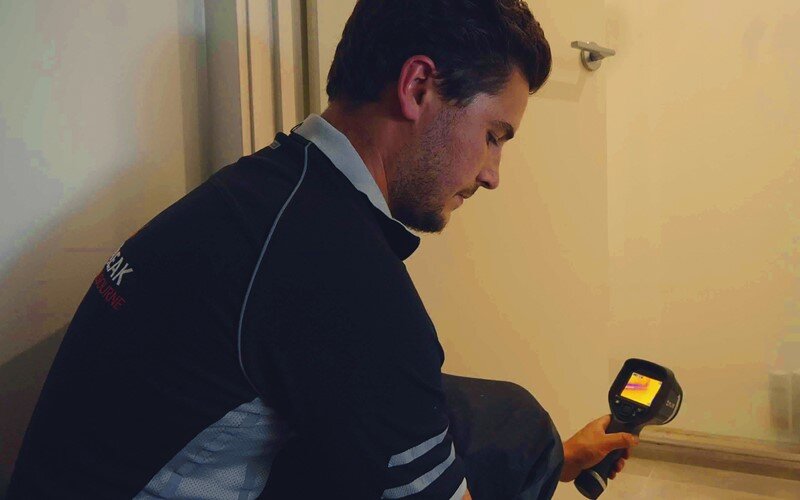How to Locate and also Repair Service Water Leaks-- A Comprehensive Overview
How to Locate and also Repair Service Water Leaks-- A Comprehensive Overview
Blog Article
We've uncovered this article about Top leak detection hacks down the page on the internet and concluded it made sense to talk about it with you over here.

Early detection of leaking water lines can minimize a potential calamity. In addition to saving you money, it will reduce the worry as well as aggravation. The minute you find a leakage, calling your plumber for fixings is the very best remedy. However, some little water leakages might not show up. If you can not find it with your nude eyes, right here are some hacks that help.
1. Take A Look At the Water Meter
Every residence has a water meter. Examining it is a guaranteed way that helps you find leakages. For beginners, switch off all the water resources. Ensure nobody will flush, utilize the tap, shower, run the washing maker or dish washer. From there, most likely to the meter and watch if it will certainly change. Considering that no person is using it, there need to be no movements. That indicates a fast-moving leak if it moves. Furthermore, if you spot no changes, wait an hour or more and also examine back once more. This suggests you might have a slow-moving leakage that could also be below ground.
2. Examine Water Intake
Assess your water expenses and also track your water intake. As the one paying it, you ought to observe if there are any disparities. If you detect sudden changes, despite your intake being the same, it means that you have leaks in your plumbing system. Keep in mind, your water expense should drop under the exact same range on a monthly basis. An unexpected spike in your bill shows a fast-moving leak.
A stable rise every month, even with the exact same habits, shows you have a sluggish leakage that's also gradually rising. Call a plumber to thoroughly inspect your home, specifically if you feel a cozy location on your floor with piping beneath.
3. Do a Food Coloring Test
When it comes to water usage, 30% comes from commodes. If the shade in some way infiltrates your bowl throughout that time without flushing, there's a leak in between the storage tank as well as dish.
4. Asses Outside Lines
Do not neglect to check your outdoor water lines too. Test spigots by connecting a yard pipe. Needs to water permeate out of the link, you have a loosened rubber gasket. Change this and also ensure all links are limited. If you have actually obtained a sprinkler system, it will aid get it properly examined and also kept each year. One tiny leak can waste lots of water as well as surge your water bill.
5. Examine and Assess the Scenario
Homeowners need to make it a routine to check under the sink counters and also also inside cabinets for any kind of bad odor or mold growth. These 2 red flags show a leak so punctual interest is required. Doing regular evaluations, also bi-annually, can save you from a significant issue.
More notably, if you know your residence is already old, maintain a watchful eye on your heating units, hose pipes, pipelines etc. Check for stainings and also weakening as most pipelines and home appliances have a life span. They will additionally normally wear away as a result of damage. If you presume leaking water lines in your plumbing system, do not wait on it to intensify. Call an expert plumber right now so you don't end up with a terrible mess in your house.
Early discovery of leaking water lines can alleviate a possible calamity. Some little water leaks may not be visible. Examining it is a surefire method that aids you uncover leakages. One small leak can squander loads of water as well as increase your water bill.
If you believe dripping water lines in your plumbing system, do not wait for it to escalate.
WARNING SIGNS OF WATER LEAKAGE BEHIND THE WALL
PERSISTENT MUSTY ODORS
As water slowly drips from a leaky pipe inside the wall, flooring and sheetrock stay damp and develop an odor similar to wet cardboard. It generates a musty smell that can help you find hidden leaks.
MOLD IN UNUSUAL AREAS
Mold usually grows in wet areas like kitchens, baths and laundry rooms. If you spot the stuff on walls or baseboards in other rooms of the house, it’s a good indicator of undetected water leaks.
STAINS THAT GROW
When mold thrives around a leaky pipe, it sometimes takes hold on the inside surface of the affected wall. A growing stain on otherwise clean sheetrock is often your sign of a hidden plumbing problem.
PEELING OR BUBBLING WALLPAPER / PAINT
This clue is easy to miss in rooms that don’t get much use. When you see wallpaper separating along seams or paint bubbling or flaking off the wall, blame sheetrock that stays wet because of an undetected leak.
BUCKLED CEILINGS AND STAINED FLOORS
If ceilings or floors in bathrooms, kitchens or laundry areas develop structural problems, don’t rule out constant damp inside the walls. Wet sheetrock can affect adjacent framing, flooring and ceilings.
https://www.servicemasterbyzaba.com/blog/how-to-detect-water-leakage-in-walls/

I have been very fascinated with Finding hidden leaks and I hope you liked our blog posting. In case you liked our article please don't forget to pass it around. I am grateful for your time. Come back soon.
Report this page